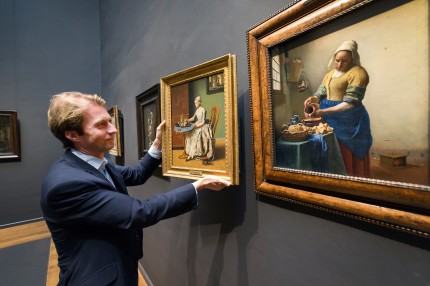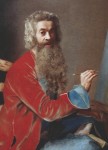 Jean-Etienne Liotard (1702-1789) was a Swiss-French artist of Huguenot extraction who is best known today for his very fine pastels. Trained as a miniaturist in Geneva and portrait painter in Paris, Liotard preferred medium was pastel on paper. They make up the overwhelming majority of his surviving work, 540 individual pieces, as opposed to only 30 oil-on-canvas paintings. In his time, Liotard was very much in demand as a portraitist and miniaturist. He travelled extensively through Europe, staying in Paris, Naples, Florence and Rome before going to Constantinople in 1738 where he lived for four years.
Jean-Etienne Liotard (1702-1789) was a Swiss-French artist of Huguenot extraction who is best known today for his very fine pastels. Trained as a miniaturist in Geneva and portrait painter in Paris, Liotard preferred medium was pastel on paper. They make up the overwhelming majority of his surviving work, 540 individual pieces, as opposed to only 30 oil-on-canvas paintings. In his time, Liotard was very much in demand as a portraitist and miniaturist. He travelled extensively through Europe, staying in Paris, Naples, Florence and Rome before going to Constantinople in 1738 where he lived for four years.
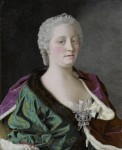 He returned from Constantinople with a great big bushy beard, a taste for Turkish dress and the crowned heads of Europe lining up for his services. He lived in Vienna from 1743 to 1745 where he made several portraits of the Empress Maria Theresa and her family. In 1748 he was in Paris painting King Louis XV and his family. In 1755 it was London and the Prince of Wales’ turn. His portraits were notoriously expensive, driving the bitter rival artist Andrea Soldi to grumble that the English measured “the value of his works by the length of his beard.”
He returned from Constantinople with a great big bushy beard, a taste for Turkish dress and the crowned heads of Europe lining up for his services. He lived in Vienna from 1743 to 1745 where he made several portraits of the Empress Maria Theresa and her family. In 1748 he was in Paris painting King Louis XV and his family. In 1755 it was London and the Prince of Wales’ turn. His portraits were notoriously expensive, driving the bitter rival artist Andrea Soldi to grumble that the English measured “the value of his works by the length of his beard.”
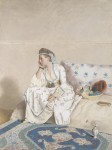 After his London sojourn, Liotard went to Holland. He stayed for a year, studying the masters of the Dutch Golden Age and building a collection of more than 60 paintings from the period. He also found himself a wife: Marie Fargue, a Dutch Huguenot who posed in Turkish dress for one of his loveliest pastel portraits, now in the collection of the Rijksmuseum.
After his London sojourn, Liotard went to Holland. He stayed for a year, studying the masters of the Dutch Golden Age and building a collection of more than 60 paintings from the period. He also found himself a wife: Marie Fargue, a Dutch Huguenot who posed in Turkish dress for one of his loveliest pastel portraits, now in the collection of the Rijksmuseum.
Liotard was strongly influenced by the Dutch artists of the 17th century. Even before his sojourn in Holland, his portraits were unusually restrained and naturalistic at a time when the fashion was for very stylized portraits with contrived poses, symbolic gestures and accoutrements conveying the wealth, power, profession and/or abilities of the subject. The intimate spaces, plain painted walls, varied textures and scenes from daily life captured in the works of Jan van Huysum, Gerrit Dou, Frans van Mieris and Johannes Vermeer inspired Liotard.
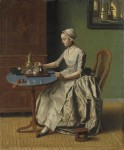 With one small oil-on-canvas painting, A Dutch girl at breakfast, Liotard became one of the first non-Dutch 18th century artists to create an explicit homage to the Golden Age masters. The painting depicts a modestly attired young woman seated a tripod table pouring a beverage (both coffee and chocolate have been proposed) into a cup. She sits in a classically Dutch interior. There’s a simple wood armoire against the wall, a foot-warmer on the floor beside her chair and, just in case the reference wasn’t clear enough, there’s a 17th-century Dutch painting of a church on the wall.
With one small oil-on-canvas painting, A Dutch girl at breakfast, Liotard became one of the first non-Dutch 18th century artists to create an explicit homage to the Golden Age masters. The painting depicts a modestly attired young woman seated a tripod table pouring a beverage (both coffee and chocolate have been proposed) into a cup. She sits in a classically Dutch interior. There’s a simple wood armoire against the wall, a foot-warmer on the floor beside her chair and, just in case the reference wasn’t clear enough, there’s a 17th-century Dutch painting of a church on the wall.
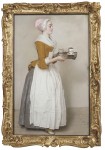 One of less than three dozen Liotard oil paintings and one of the only genre paintings he did (he was well-known for genre treatments in pastel, but not in oil), A Dutch girl at breakfast is rare and of great art historical significance as an example of the spreading influence of Dutch Golden Age painters. Liotard kept the painting for close to 20 years. He finally sold it in 1774 at a Christie’s auction. The buyer was Sir William Ponsonby, 2nd Earl of Bessborough, an old friend and patron of Liotard who had traveled with him in 1738 and would go on to become his biggest supporter, buying more than 70 of his works over the decades.
One of less than three dozen Liotard oil paintings and one of the only genre paintings he did (he was well-known for genre treatments in pastel, but not in oil), A Dutch girl at breakfast is rare and of great art historical significance as an example of the spreading influence of Dutch Golden Age painters. Liotard kept the painting for close to 20 years. He finally sold it in 1774 at a Christie’s auction. The buyer was Sir William Ponsonby, 2nd Earl of Bessborough, an old friend and patron of Liotard who had traveled with him in 1738 and would go on to become his biggest supporter, buying more than 70 of his works over the decades.
A Dutch girl at breakfast stayed in the Ponsonby family for 242 years until it was sold at Sotheby’s in July 2016 for $5,695,000. The buyer was revealed last month as the Rijksmuseum which has now installed Liotard’s Dutch girl next to Vermeer’s Milkmaid in the Gallery of Honour. Inspiration and inspired will only briefly be side by side. By the end of the month, the painting will be installed in its permanent location, the 18th century arts gallery. There it will be reunited with a host of brothers and sisters, the museum’s extensive collection of Liotard pastels that were donated by descendants of his and Marie Fargue’s eldest son.
